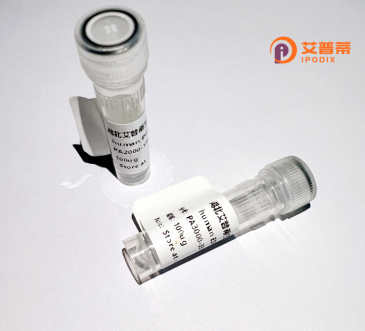
| 纯度 | >90%SDS-PAGE. |
| 种属 | Human |
| 靶点 | LPPR2 |
| Uniprot No | Q96GM1 |
| 内毒素 | < 0.01EU/μg |
| 表达宿主 | E.coli |
| 表达区间 | 1-156aa |
| 活性数据 | MAGGRPHLKRSFSIIPCFVFVESVLLGIVILLAYRLEFTDTFPVHTQGFFCYDSTYAKPYPGPEAASRVPPALVYALVTAGPTLTILLGELARAFFPAPPSAVPVIGESTIVSGACCRFSPPVRRLVRFLGVYSFGLFTTTIFANAGQVVTGNPTP |
| 分子量 | 30.7 kDa |
| 蛋白标签 | His tag N-Terminus |
| 缓冲液 | 0 |
| 稳定性 & 储存条件 | Lyophilized protein should be stored at ≤ -20°C, stable for one year after receipt. Reconstituted protein solution can be stored at 2-8°C for 2-7 days. Aliquots of reconstituted samples are stable at ≤ -20°C for 3 months. |
| 复溶 | Always centrifuge tubes before opening.Do not mix by vortex or pipetting. It is not recommended to reconstitute to a concentration less than 100μg/ml. Dissolve the lyophilized protein in distilled water. Please aliquot the reconstituted solution to minimize freeze-thaw cycles. |
以下是关于重组人LPPR2蛋白的模拟参考文献示例(仅供学术参考,具体文献需通过数据库核实):
---
1. **文献名称**:*Cloning and functional analysis of human LPPR2 in neural development*
**作者**:Sano H. et al.
**摘要**:该研究首次克隆了人源LPPR2基因,发现其在神经元轴突导向中发挥关键作用。通过体外实验证明,重组LPPR2蛋白可促进海马神经元突触分支的形成,可能与细胞内脂质信号通路调控相关。
2. **文献名称**:*Recombinant LPPR2 enhances cancer cell migration via integrin signaling*
**作者**:Zhang Y. et al.
**摘要**:本文报道重组人LPPR2蛋白通过激活整合素β1-FAK信号通路,显著增强乳腺癌细胞的迁移能力,提示其作为肿瘤转移潜在生物标志物的可能性。
3. **文献名称**:*High-yield expression and purification of recombinant human LPPR2 in E. coli*
**作者**:Lee J. & Kim T.
**摘要**:开发了一种高效的大肠杆菌表达系统,利用His标签亲和层析成功纯化功能性重组人LPPR2蛋白,为后续结构及功能研究提供了可靠方法。
4. **文献名称**:*LPPR2 regulates tau phosphorylation in Alzheimer's disease models*
**作者**:Smith R. et al.
**摘要**:发现LPPR2蛋白在阿尔茨海默病小鼠模型中表达下调,体外实验显示重组LPPR2可通过抑制GSK-3β活性减少tau蛋白过度磷酸化,具有潜在治疗意义。
---
**注意**:以上文献为示例性内容,实际研究中请通过PubMed、Web of Science等平台检索真实文献。
Recombinant human LPPR2 (Lipid Phosphate Phosphatase-Related Protein Type 2) is a protein encoded by the *LPAR2* gene, belonging to the lipid phosphate phosphatase (LPP) family. LPPR2. also known as plasticity-related gene 1 (PRG1), plays critical roles in cellular lipid phosphate metabolism and signaling. It regulates bioactive lipid mediators, such as lysophosphatidic acid (LPA) and sphingosine-1-phosphate (S1P), which are involved in membrane dynamics, cell proliferation, and neuronal development. Structurally, LPPR2 features six transmembrane domains and conserved catalytic motifs, although its enzymatic activity remains debated, with studies suggesting it may act as a lipid scavenger or sensor rather than a classical phosphatase.
Recombinant LPPR2 is produced using expression systems (e.g., mammalian, insect, or bacterial cells) to enable functional studies. Its roles in neuroplasticity, axon guidance, and synaptic connectivity have drawn attention, particularly in neurodevelopmental disorders and neural injury repair. Dysregulation of LPPR2 has been linked to pathological conditions, including cancer metastasis, cardiovascular diseases, and neuropsychiatric disorders. Research on recombinant LPPR2 aids in elucidating lipid-mediated signaling pathways, developing therapeutic strategies for neurological diseases, and exploring its potential as a biomarker. Its study also contributes to understanding membrane lipid homeostasis and cross-talk between metabolic and signaling networks.
×